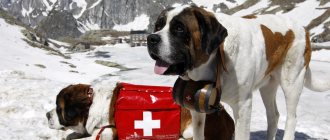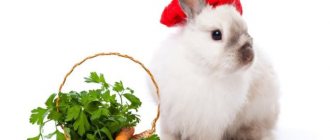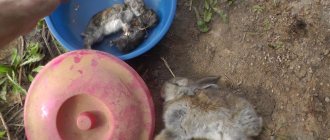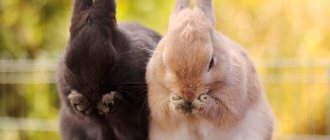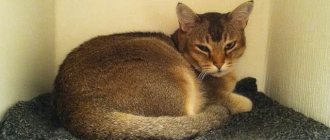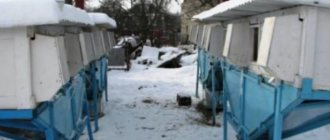Expert opinion
Dobryshev Sergey Anatolievich
Professional rabbit breeder and hare breeder with 30 years of experience
Rabbit farming is a profitable and interesting activity that requires certain skills when running this business. To get good results, you need to choose the right breed wisely. California rabbits are an ideal option due to their inherent qualities. Good results can be obtained even by novice rabbit breeders, which is facilitated by the combination of sufficient productivity with moderate requirements for their care and living conditions.
California rabbits have good adaptation to various climatic conditions and high survival rate. They are characterized by rapid growth and produce high-quality fur and meat.
California rabbits - all about the breed
Photo:
The Californian breed rabbits look very interesting, why are they raised not only for the purpose of producing delicious meat, but also for decorative purposes.
Body Features
The body constitution of this breed of animals, according to external data, completely corresponds to meat breeds. The body itself is wide, well-knit, has a pronounced cylindrical shape, with well-developed muscles, especially in the lumbosacral part, where the bulk of the meat mass is concentrated.
The bony skeleton is light and thin, but quite strong. The neck and paws are short, the paws are covered with short and hard hairs. The head is small, distinguished by a humped nose and red eyes, short ears up to 11 cm long. There is no dewlap. The coat throughout the body is dense and dense, padded.
Color
Newborns have completely white fur. As they grow older, the ears, paws, nose and ears turn black, with the spots having clear and even boundaries. Sometimes the spots may have a different shade - chocolate, lilac, blue, smoky.
Important! The spotting of rabbits of this breed is often similar to the signs of the Butterfly variety.
But experienced breeders can easily see the differences, which are the dark color of the eyes and the specific shape of the spot on the nose - in the form of a moth.
Features and history of the breed
It is believed that this breed was bred by American farmer George West, who lives in the state of the same name as the variety.
For a long time, individuals obtained from crossing a chinchilla, Russian ermine and New Zealand white were considered a hybrid species, and the breed was registered only in the 30s of the last century.
The farmer saw his main task as breeding a species of rabbits with wonderful fur and at the same time fast maturing. The breed gained its vocation through practice; for many years West could not officially register it, but his livestock sales grew exponentially every year.
The California rabbit has a medium-sized body with a cylindrical shape. In addition to white color, there are chinchilla and blue, smoky, chocolate. There are also spotted individuals, which are often confused with the legendary butterfly, especially at a young age, when the color has not yet “ripened.”
Photo gallery of Californian rabbits:
Productivity
When choosing Californian breed rabbits for breeding, one must take into account the characteristics of this species.
First of all, it is noted that it is beneficial in terms of efficiency for private and subsidiary livestock farming of any scale. Cash investments are minimal, and the performance of such a business ultimately turns out to be excellent.
Here are the qualities inherent in Californian rabbits:
- Newborn rabbits weigh only 45 g, but gain weight quite quickly and reach 4.5-5.5 kg by the age of 7 months. Of these, about 80% of the mass is valuable meat, while fat is only 2.5-3%.
- The offspring during mating is 7-15 individuals, which is quite a decent indicator. And due to the inherent highly developed maternal instincts and milk production, the development of young animals occurs very quickly. As a result, with the right approach, you can get up to 35-45 rabbits from one female in a year.
- The density index is another important indicator by which the productivity of breeds is directly assessed. For California rabbits, according to the description in the classifier and reviews, it is 60-65%. This value is the maximum possible when raising rabbits for meat.
What are the advantages and disadvantages of the breed?
Also check out these articles
- The most popular sheep breeds
- Powdery mildew on currants
- Mulard duck breed
- When to plant lobelia seedlings in 2021
Daily growth of California rabbits
California rabbits gained their popularity due to a number of advantages.
- The breed belongs to the meat category. Newborn rabbits weigh only 45 grams, but by 2 months they reach 2 kg of weight! After another month they have a mass of 3 kg. After five months, when they reach 3.7 kg, their growth decreases; from this age they can be slaughtered.
- The breed's fur is highly prized due to its pure white color. Dark spots are found only on the limbs of the animal, so they can be completely excluded from the final material. Most often, the skins are sold in bulk to clothing factories. If you wish, you can do your own sewing and sell clothes for a high price.
- The advantage of the breed is the excellent maternal instinct of the female. Females treat the rabbits with care and also have a lot of milk, so the young do not need additional feeding until they are weaned from the mother.
- Thanks to their amazing coloring and pleasant appearance, they are often kept as pets. In this case, keeping is possible in a house or apartment. Such individuals participate in exhibitions and competitions.
The Californian breed does not have many disadvantages.
- When kept at home for decorative purposes, minor problems may arise. The first thing to control is wires and furniture, which the rabbit can simply chew off. The second point is the large size. It will be difficult for a child to lift, carry or simply stop an adult animal; only a teenager or an adult can cope with this task. Therefore, it is recommended to have a rabbit only if there are no children or if an adult is always with them.
- Adults are susceptible to stress. They are not afraid of a new climate, but new conditions or roommates, loud sounds, aggression from the outside can seriously frighten the animal. In rare cases, severe stressful situations have led to the death of a member of the species.
Origin story
When selecting the Californian breed of rabbits, there was a specific task - to breed animals with high quality fur and a quick increase in meat mass. The work was carried out over several years, as a result of which even higher results were achieved than expected.
The authorship was assigned to a Californian farmer who was engaged in professional rabbit breeding - George West.
The main donors of this species were the New Zealand white breed, the Russian ermine, and the Soviet chinchilla. The breed was officially recognized in 1928, although it was bred much earlier.
External features
The first thing people notice when looking at Californian rabbits is the dark points, which create a contrast to the main color - white. The breed took this color from the Russian Ermine, one of the ancestor breeds.
External features are shown in the table:
| Appearance | Characteristics |
| Color | White, only the nose, ears, paws and tail are dark colored |
| Torso | Cylindrical, slightly widened towards the rear |
| Head | Small, round |
| Eyes | Of red color |
| Ears | Small, erect, 10.5–11.5 cm, rounded at the ends |
| Mustache | White |
| Neck | Short |
| Paws | Strong and shortish, thick and well furred |
| Tail | Short, set close to the body |
| Claws | Black or brown |
Price and rejection criteria
When purchasing California rabbits for the purpose of breeding and raising them for slaughter, count on an estimated cost of 4,000 thousand rubles per individual. You need to purchase from a breeder with a good reputation, but if he is located in another area, then you will have to pay another 2,000 rubles for delivery.
Important! Please note that animals of this species can easily travel distances of up to 100 km. If a longer transportation is expected, then the rabbits are given special anti-stress medications.
To avoid problems when growing, carefully inspect the specimens offered for sale. Healthy rabbits should be active, well-fed, with clear and clean eyes, a clean nose and ears, and smooth and shiny coat.
Important! The nature of Californian rabbits is usually calm and friendly. A healthy individual should also be moderately inquisitive and not shy.
Rejection criteria:
- A very large dark spot on the nose.
- Eye color inappropriate for the breed.
- Elongated or not erect ears.
- Weight - over 5.5 or less than 3.5 kg.
- There are extra dark spots on the body.
How to choose the right rabbit when buying
It is advisable to purchase individuals for fattening or breeding on large farms where all the necessary veterinary measures are carried out. Since the rabbit is an animal susceptible to viruses and infections, young animals and adults are vaccinated against common diseases.
You can buy young animals from well-known breeders or at specialized exhibitions, knowing the main characteristics of Californian rabbits.
Healthy California rabbits look like this:
- they are active and curious; when you try to pick them up, they actively resist;
- the hair on the face and paws is clean and dry;
- pea-shaped animal droppings, no diarrhea;
- the inner surface of the ears without signs of sores or scratches;
- the eyes and nostrils are clean, the rabbit does not sneeze;
- the body is proportional, the stomach is not bloated.
The appropriate age for a baby rabbit to purchase is 2 months. At this age, young animals no longer need mother's milk; animals consume adult food: grain, vegetables, hay.
Reviews
Despite the fact that immediately after the breeding of this breed, animals were treated with doubt for some time, today all their advantages and disadvantages have been assessed.
They are not only described in the characteristics of the Californian breed, but are also noted in numerous reviews from breeders and rabbit breeders.
Pros:
- Precocity. The development of young animals occurs at lightning speed, with the result that within six months the individuals are suitable for slaughter.
- Low feeding costs. Since the diet of this breed does not require specific food, and rabbits grow quickly, this affects the maintenance costs - they are much lower than when breeding any other meat breed. The final cost of meat is less, and the business benefits are greater.
- Unpretentiousness in content. Californian rabbits easily adapt to conditions and do not require special care or increased care when breeding. This affects not only feeding, but also the frequency of veterinary attention.
- The versatility of fur. The skins of these animals are always in high demand, since fur processing is much easier than other breeds.
Minuses:
- Relatively small offspring.
- Low maximum body weight.
Productive qualities
Adult animals gain weight up to 5 kg - males, females are slightly smaller and weigh 4.5 kg. Having reached the age of 7 months, the rabbit gains maximum weight, and there is little point in keeping them any longer. Some breeders send Californians to slaughter even earlier, as soon as they reach 5 months of age, this is the period associated with the end of intensive growth.
The slaughter yield for rabbits is 60% of live weight, pure meat is about 85%, another 2.5% is fat, the rest is bones.
California rabbits weight by month
There are rabbits that gain more weight, but this does not mean that raising Californians on the farm is an unprofitable undertaking. It is worth calculating the money that will have to be spent on obtaining a kilogram of meat. Due to the short period of maintenance, large financial losses will not occur.
Breeders also note the fact that five-month-old rabbits have better quality meat products than older animals. In addition, Californians have a higher knock-down index than other meat rabbits.
Breeding
When thinking about breeding Californian rabbits, you only need to know the following features of this species:
- Individuals intended for reproduction live on average about 5 years.
- The optimal age for breeding is from 5 months for females and from 7 months for males. It is during this period that rabbits reach puberty. You can also be guided by the indicator of the first molt - plan mating after the first one ends. The weight of the individual should be within 5 kg - obesity, as well as lack of weight, can negatively affect performance.
Important! Higher reproductive rates and characteristics of the resulting offspring are inherent in individuals that have not only the standard spots for the Californian rabbit breed, but also a smoky coat color.
What you need to know:
- It is better to carry out mating in the male’s cage - this way he will feel more confident. You must first remove drinking bowls, feeders, and other objects that may interfere with the process from the cage. Sometimes it is necessary to hold a female who has not yet had contact so that the male can better settle down. The whole process generally takes a few minutes, but depends on the temperament of the selected individuals.
- Fertilization occurs the very next day after mating. Pregnancy lasts 28-35 days. Here you need to know that in the last week the females become aggressive, so it is better to put them in separate cages. The first litter can be quite long and painful for the female, so it is advisable to monitor the veterinarian so that, if necessary, he can provide the necessary assistance.
Important! Inbreeding of rabbits is unacceptable, as this causes their degeneration. Therefore, when the generation of females grows up and they reach sexual maturity, the male rabbit is caught and replaced with another individual.
What else:
- When nesting, rabbits tear out their fur from their abdomen and use it to arrange a place suitable for their offspring - this is a natural process.
- If there is a disproportionate number of broods in different females, you can move the babies so that the females’ feeding loads are even. Milk feeding continues for 3 months, then the young animals can be accustomed to a normal diet.
Conditions of detention
Keeping California rabbits at home is kept to a minimum. For quick breeding, rabbits are kept in a cage. Some breeders keep New Zealand and California breeds together unless there is fighting. At the same time, the Californian breed allows the use of cells 1.5 times smaller than, for example, needed for representatives of the Gray Giants. To create adequate conditions, a dwelling with dimensions of 120 x 60 x 60 cm is suitable. Good adaptive abilities of animals help them withstand cold weather. When placing rabbits, you need to pay attention to their age: it is best that it is approximately the same for all, which will simplify basic care.
To keep animals, it is not necessary to buy special cages; you can make them yourself with little expense of resources. To do this, you will need wooden beams with dimensions of 5 x 5 cm for the frame. A floor net is fixed in the feeding area. Special attention should be paid to the organization of the queen cell and feed bunker: they should be as comfortable as possible for constant access. The floor under the queen cell is covered with wood so that it is solid and securely fixed. When designing the roof, the location of the rabbitry must be taken into account. If it will be outdoors, it is better to make it from waterproof materials and on a slope so that precipitation does not immediately accumulate.
Raising rabbits in cages and pits
When choosing a place to install the cage, it is necessary to take into account that this breed does not like dampness; drafts and direct sunlight should be avoided. It is better to keep breeding females in closed areas with good ventilation.
California rabbits can also be kept in special pits: such conditions are more natural and suitable for industrial rearing. To set up a rabbit hole, you first need to dig it with approximate dimensions of 2x2x1 m.
After this, the walls are strengthened (best using slate) and the floor is laid from mesh or boards. The pit itself must be covered with a roof and with a fence installed around it. The advantage of using the method described above is that the rabbit breeder has less work to do, because the rabbits independently dig their own holes, mate, and raise offspring. It remains to provide systematic feeding and water, as well as selection. To do this, a male whose generation has already reached sexual maturity is caught from a hole.
Feeding
Rabbits are, in principle, animals whose diet must be carefully monitored. And if they are raised to obtain good quality meat, then feeding rules should be a priority.
How often and when to feed?
To ensure balanced and nutritious meals, stick to the following schedule:
- 5 times a day - for young rabbits that have just been separated from their mother, you can gradually reduce the frequency of feedings to 3 times a day;
- In winter, the first feeding is best done at 8 am;
- in summer - at 6 am.
What can you feed?
Depending on the season, the cost of feeding Californian rabbits can be easily minimized, since they do not have to buy expensive special food; they can get by with affordable products.
The diet should include:
- Green food. This includes meadow, field, forest and garden herbs - you can make assorted herbs using burdock, tansy, dandelion, clover, wormwood, plantain, sainfoin. Grass cut from the lawn will also work well, just make sure it is dry. Important! It is fundamentally important when feeding rabbits that the animals have free access to clean and fresh water. In winter you need to make sure it is warm.
- Vegetables. The menu includes pumpkin, rutabaga, zucchini, cabbage, and carrots.
- Escape. You can give rabbits leaves and branches of maple, ash, linden, birch, aspen, bean tops, and peas.
- Cereals and beans. Oats, soybeans, corn, and peas are suitable.
- Delicacies. They are included occasionally and in small quantities - no more than 2% of the total daily intake. Such products include apple, kohlrabi, banana, broccoli, parsley.
- Other components. To ensure proper nutrition with the required amount of vitamins and minerals, be sure to include meat and bones, fish meal, and bran in the rabbits’ diet.
What should you not feed rabbits?
- Dairy products. Despite the fact that these animals need an optimal amount of protein, dairy products - cottage cheese, milk, whey, etc., are highly undesirable to include in their diet. It is better if the proteins are of plant origin.
- Vegetables. This is not a contradiction to the rules of feeding. The bottom line is that vegetables should be present in the diet of rabbits, but some types are absolutely not suitable, and you need to be aware of them. So, you should not give your rabbits cucumbers, onions, red cabbage, tomatoes, new potatoes, beets and eggplants.
- Fruits. The products listed above can be included, but in this case it is better to avoid exotic foods - avocados and mangoes are not for rabbits.
- Cereals. The situation is the same as with vegetables and fruits. There are some grains that are absolutely not suitable for feeding Californian rabbits - these are rye, millet, rice and millet. Also not suitable are legumes - red and black, young peas.
- Poisonous herbs. When mowing the grass yourself, check the lawn in advance to ensure that celandine, hemlock, wild radish, horsetail, as well as dream grass, poppy, and buttercup do not grow on it. Even one blade of these plants among an armful of grass can lead to the death of rabbits.
- Any baked goods. Here we mean not only sweets - cookies, cakes, gingerbreads, but even ordinary white yeast bread.
What are the features of feeding?
We recommend reading our other articles
- Simmental cow breed
- Plum compote
- Cherry compote
- The best varieties of thick-walled sweet peppers
Basically, Californian breed rabbits are bred to produce high-quality meat, so nutrition must meet the standards, otherwise weight gain will be small.
Maximum daily supply of succulent feed to rabbits, g
Immediately after the animal is separated from its mother, it is necessary to begin intensively feeding the young animals. The basis of the diet is hay, brooms, vegetables, grains, crackers, dairy products, dry branches. You can buy special food for rabbits. There is everything an animal needs for rapid growth, development and improvement of the immune system. The diet must contain meat and bone meal and vitamin and mineral supplements. Greens are given only dried.
The water in the drinking bowls is changed daily. Animals drink a lot, especially in the summer when it’s hot. It is important to place the drinker so that it is not exposed to the sun. It is recommended to use nickel drinking bowls for rabbits; they are convenient and compact. Even in winter, the animal needs access to fresh, clean water, since using snow for drinking will have an undesirable effect on the rabbit’s health.
Care and maintenance of California rabbits
The unpretentiousness of Californian rabbits also affects the low cost of their maintenance. In this regard, it is sufficient to comply with such conditions.
Cells:
- The ideal place is closed rooms and cages. The volume is calculated based on 0.3 m2 of area per individual or cell size of 120 * 60 * 60 cm. For fertilized females, it is better to increase the space to 0.4 m2. An adult should stand freely inside on its hind legs - this is how the optimal height of the cage is determined. Important! It is better not to use chipboard for cells, since the material can swell and crumble with increased humidity and temperature fluctuations.
- Floors can be made of mesh even without underlayment. If you do make bedding, you can use sawdust or straw. Important! Be sure to remove feces and change the litter at least once a week.
- The location of the cage is in the shade, without direct access to sunlight and drafts.
Pits
With large-scale breeding of Californian rabbits, they can be kept in pits.
To do this, follow the following rules:
- Parameters: 2 meters wide and long, 1 meter high.
- It is better to reinforce the walls with concrete, slate or sheet iron.
- The bottom is left earthen or boards and mesh are laid, leaving the opportunity for pets to create holes.
- The roof is made of available transparent material, leaving hatches for feeding. It is better to design it with a slight slope so that during rain precipitation does not accumulate on the surface.
Other nuances of care
In addition to the correct conditions of detention and feeding, the following nuances of care are also important:
- Combing the fur to prevent tangles from forming. To do this, use hard brushes, as well as special combs for cats and dogs.
- Nail trimming once a month. In this case, you need to be careful not to touch the blood capillaries.
- Cleaning the ears and checking the eyes for inflammation, redness, and discharge.
Correct content
Individuals of this variety are also in demand due to their excellent adaptability. They quickly adapt to new living conditions, begin to actively develop, and gain weight. At the same time, it is still necessary to maintain a certain minimum for them to live.
Large scale breeding
Let's consider the requirements for the cell. The height of the rabbit's living room, cage, must be sufficient for the animal to be able to stand on its hind legs, stretch, and move normally actively. A compact shelter must be equipped inside, where the rabbit feels protected, hidden from prying eyes, and can rest peacefully and get enough sleep.
Feeders with drinkers in the correct cage are always in the free access area. The animal must not be restricted in food or drink.
Feeders
The filler is taken in accordance with hygiene standards. The cage is always kept in order, so the bedding retains odor, allows moisture to pass through and absorbs moisture.
The location where the rabbits’ home is located is of great importance. The area should be semi-shaded and ventilated. At the same time, rabbits are protected from hypothermia or overheating. Drafts and sunshine are contraindicated.
Rabbit nest
Care
Competent care does not end with feeding and maintaining hygiene. Hygiene of the skin, ears and claws, coat and eyes is of great importance. Animals must be carefully examined at least once a week so that if any problem arises, it can be immediately detected and promptly eliminated.
Wool requires special care. There should be no tangles. If they suddenly form, they must be cut off. Comb the fur with special brushes. It is advisable to choose brushes made from natural fibers. It is advisable to do this at least once a week. A healthy purebred Californian rabbit has soft, thick fur that has a shine and a deep, noble shade.
Healthy baby rabbit
The skin must be clean and smooth. You need to make sure there are no pimples, scabs, red spots or damage. When they appear, the body thus signals malfunctions: for example, stress, hormonal imbalance, improper functioning of the liver and gastrointestinal tract.
The ears also need special care. They are always kept clean. You have to clean them from time to time. This should be done regularly, about once a month, and also when any contamination is detected. Turunda is used, soaked in a solution of boric acid with a weak concentration.
Rabbits must be examined constantly. A healthy individual's ears are erect, there are no scabs or spots on them, and the fur is dense
Animals' eyes should be examined thoroughly every day. Keep a close eye on them and monitor their condition. Sometimes one eye begins to water, for example, because of a speck of dirt in it, or because of an injury. When there is dry discharge or mucus, they must be carefully removed using a piece of soft cloth soaked in warm water. If both eyes water, fester, and turn red, this is probably evidence of the development of an inflammatory process, conjunctivitis. It is necessary to immediately contact a veterinarian, and then carry out therapy with medications and drops.
Feeding
A balanced, thoughtful diet determines the productivity, good health and activity of animals. It is important to know exactly what food California rabbits need, what exactly to feed them, and how their menu depends on the time of year.
Feeding rabbits
Young animals develop at an accelerated pace, so they need food enriched with proteins. Meat or fish meal, proteins, and dairy products are needed every day. Classic feed is also needed: feed, branches, root crops and herbs, hay. The water in the drinking bowls must be fresh at all times. In summer, you need twice as much water, and in winter, the water for drinking bowls is specially heated.
The number and frequency of feedings directly depend on the age of the animals. Adults eat 2-3 times a day. Young rabbits, recently weaned from their mother's milk, need five feedings per day.
Remember! The quality of the diet and its balance are of great importance. Animals need valuable microelements and a complex of vitamins. Rabbits are unpretentious in food, so there are usually no problems with preparing a diet. Be sure to alternate plantain with clover, tansy with dandelions, burdock with sainfoin.
Rabbit nutrition
In winter, silage can successfully replace green grass. California rabbits will happily eat zucchini and cabbage, pumpkin and carrots. You can diversify the menu by adding kohlrabi, parsley, and bananas. But such delicacies must be given with caution, in limited quantities. This will avoid gastrointestinal disorders and allergic reactions. Make sure that your diet includes barley and oats, legumes and corn, and bran. Rough food is also needed: aspen and ash branches, as well as linden and maple branches, are suitable for animals.
What not to feed rabbits.
It is very important for a farmer to learn to distinguish healthy foods from harmful products that threaten the life and health of long-eared rodents. What you should not feed rabbits, and what food will keep them healthy, we will look at in this article.
Diseases
In general, the Californian rabbit breed is famous for its good immunity. But you still need to understand what diseases can occur and their causes.
Ailments as a result of improper care:
- Pneumonia, rhinitis, bronchitis are a reaction to dampness and drafts. For rhinitis, the nose is instilled into each nostril up to 2 times a day with a solution of ecmonovocillin or furatsilin. For bronchitis, dimezin and sulfatrol are administered. For pneumonia, antibiotics are added - penicillin, biomycin.
- Inflammation of the soles of the paws can occur if the bedding in the cage is rarely changed or if it is equipped with an uncomfortable metal mesh, claws are not trimmed in a timely manner, or in case of obesity. Treatment includes rinsing with peroxide, chlorhexidine, the antibiotic Baytril, Xidicol and Dermatol ointments.
Dangerous diseases:
- Bloating occurs if animals are fed the inappropriate foods listed above. Due to gases formed in the gastrointestinal tract, animals can die within a few hours from suffocation or rupture of the intestinal walls. Therefore, it is necessary to act quickly and competently. Suitable measures include abdominal massage, as well as decoctions of dill, dandelion, wormwood, and chamomile. Activated carbon and Timpanol are used as medications.
- VHBD (viral hemorrhagic disease). A very dangerous disease transmitted through equipment and contact between rabbits. The virus persists even in the skins of animals for another 3 months. Mortality as a result of infection is 100% and occurs within 1-4 days. The only thing that can be done to exclude such a result is to carry out routine vaccination at the age of 45 and 105 days.
- Myxomatosis. This virus affects after contact between sick and healthy individuals, and it is also transmitted by bloodsucking insects. Depending on the form of the disease, the mortality rate is 30-70%. Myxomatosis cannot be completely cured; even after recovery, the rabbit remains a carrier of the virus. During treatment, immunostimulants are used to help alleviate the animal’s condition and alleviate its condition. But it is also better to carry out preventive vaccination at the age of 30 days.
Pros and cons of Californians
The advantages include the following breed indicators:
- rapid precocity. Young animals can be slaughtered from the age of six months;
- low cash costs for feed;
- unpretentiousness to living conditions;
- presence of universal white fur.
There is probably no ideal breed. Despite all the attractiveness of California rabbits, they have their drawbacks:
- infertility of females. On average, no more than 8 rabbits are born per litter;
- The maximum weight of animals leaves much to be desired.
We invite you to join our Zen channel and group on VKontakte or Odnoklassniki, where new articles are published, as well as news for gardeners and livestock breeders.
Similar articles:
- Burgundy rabbits: value and maintenance features
- What is the difference between a rabbit and a hare?
- White Pannon: how to keep rabbits and what makes them special?
Features of breeding, care
The Californian breed is famous for its high adaptive abilities, which is why it is successfully bred both in the south and in the north.
They easily tolerate frosts thanks to their fluffy paws. It is believed that the best place to keep fluffies is a specially equipped room in which a suitable microclimate has been created. When nesting, they are housed in spacious cages 120x60x60 cm.
Soft feet allow animals to feel great on mesh floors in mechanized rabbitries. It is not necessary to arrange bedding in the cages. The fur is carefully looked after. Keeping them in shed conditions is also a widespread and successful practice among domestic and foreign fur breeders. They sell rabbits to both individuals and fur farms.
At home, such beautiful animals are kept in more spacious cages than dwarf breeds. The main difficulty of home care is keeping the fur in excellent condition; in addition, if you are going to have such beauty at home, then remember that the animal does not get along well with children. Otherwise, caring for them has no special features or difficulties. Without causing much trouble to the owner, these bright-looking pets will delight the eye for about 10 years (this is their average life expectancy).
History of the breed
The history of the breed began in the first half of the 20th century in the state of California in the United States of America. It was created by breeder George West. He wanted to get a hardy, productive rabbit that would grow quickly and have a good character. Californians were developed through a mixture of breeds:
- Soviet chinchilla;
- New Zealand white;
- Russian ermine.
As a result of long-term experiments, rabbits were born that had excellent precocity, good quality skins and tasty meat. The queens of the Californian breed are fertile and caring, which ensures high survival rate of the offspring. They are inferior in weight to a white or gray giant, but they also require less food.
Breed 1: Soviet chinchilla
During breeding, the selection of animals was carried out not only according to physical indicators; preference was given to individuals with good character. That is why the Californian breed is characterized by a quiet disposition.
Breed 2: New Zealand White
Despite their precocity and excellent meat qualities, at first these rabbits failed to gain great popularity. Only by the 30s of the last century did American farmers begin to breed them. Afterwards, Californian precocious rabbits appeared on European farmsteads.
Breed 3: Russian Ermine
The American giant came to the USSR from Western countries, but at first he was not particularly in demand. Farmers thought that Californian breed rabbits were not well adapted to frosty winters and caring for them would be too labor-intensive. But the doubts turned out to be in vain, the animals perfectly adapted to the harsh climate and began to give birth.


